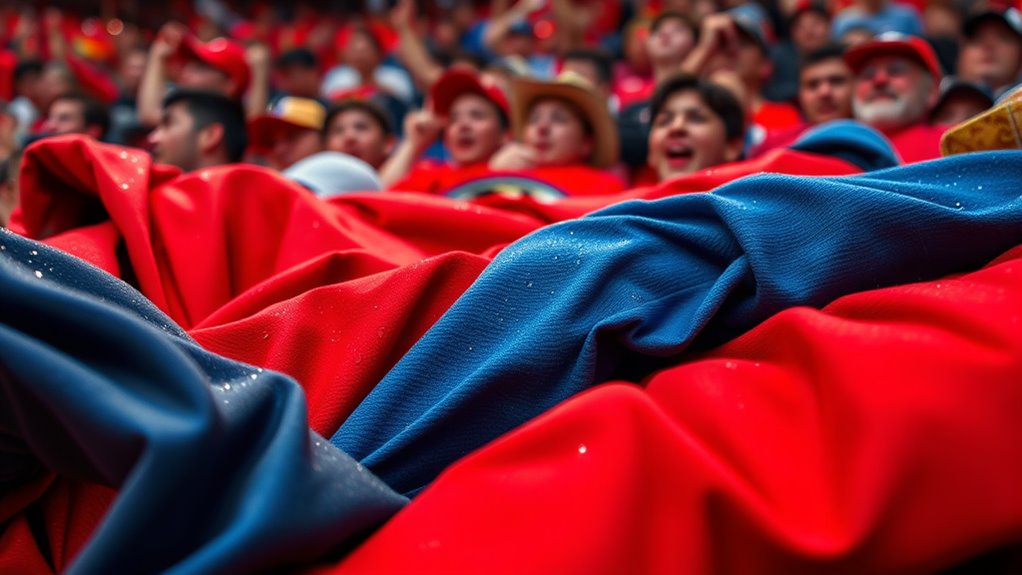Fandom’s deep attachment to team colors and rituals comes from your natural instinct to build social bonds and identify with groups. These practices tap into evolved tendencies for loyalty, competition, and shared experiences, which boost your sense of belonging and emotional well-being. Wearing team gear and participating in rituals reinforce your identity and create powerful connections. If you want to understand why these symbols mean so much to you, there’s more to uncover ahead.
Key Takeaways
- Fandom roots in social bonding and shared traditions that create emotional ties through rituals, symbols, and community experiences.
- Wearing team colors and merchandise reinforces personal identity and fosters a sense of belonging.
- Evolutionary instincts for group loyalty and competition drive fans to display allegiance through symbols and rivalries.
- Media coverage and fan rituals deepen emotional engagement, making team allegiance a core part of self-concept.
- Collective celebrations and shared experiences strengthen social bonds, making fans emotionally invested and loyal.
The Origins of Team Loyalty and Identity
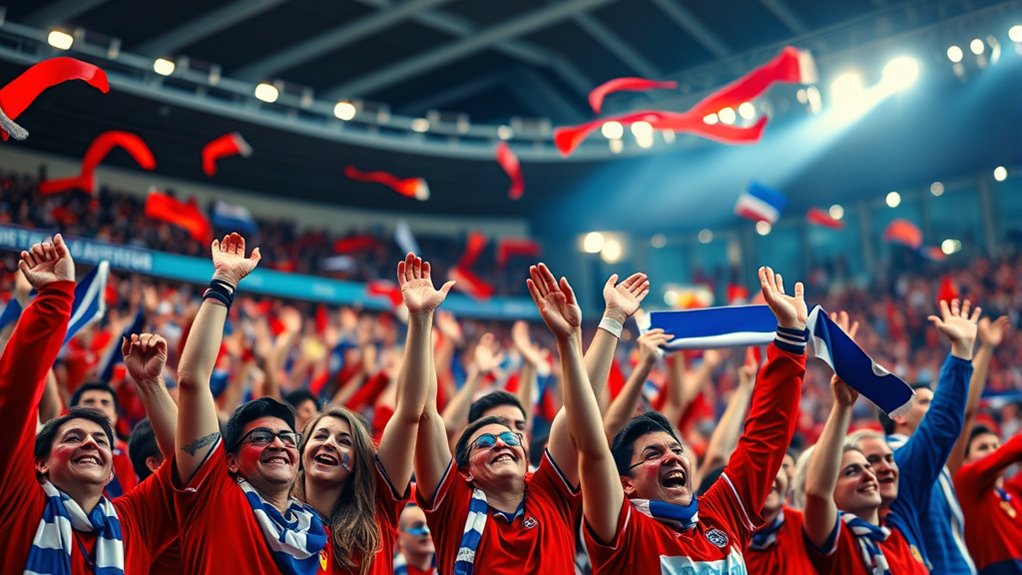
The roots of team loyalty and identity often trace back to early community ties and shared experiences that create a strong sense of belonging. You begin to recognize your team through its unique branding—colors, logos, and symbols that set it apart. This team branding fosters a collective identity, making fans feel connected beyond just the game. Fan rituals, like wearing team colors or participating in chants, deepen this bond. These rituals become a way to show allegiance and reinforce your place within the community. Over time, these shared symbols and activities strengthen your emotional attachment, shaping your loyalty. This sense of belonging through team branding and rituals becomes a core part of your identity as a dedicated supporter. Additionally, the safety features of team-related merchandise, such as official apparel and accessories, ensure that fans can express their loyalty securely and comfortably.
Psychological Drivers Behind Fandom Passion

Understanding what fuels your passion for fandom reveals how psychological factors reinforce your connection to your team. Merchandise marketing plays a key role by constantly reminding you of your team’s identity, making you feel more personally invested. Wearing jerseys or collecting memorabilia taps into your desire for belonging and pride. Fan art further deepens this connection by allowing you to express your loyalty creatively, turning abstract support into tangible, personal symbols. These activities activate emotional responses, fostering a sense of community and identity. When you engage with merchandise and fan art, you’re not just showing support—you’re reinforcing your emotional attachment, strengthening your psychological bond to your team, and fueling your passionate fandom. Additionally, the use of cultural influences in fashion provides fans with ways to incorporate their team colors and symbols into traditional or modern attire, further enhancing their sense of belonging and identity.
The Role of Social Bonding and Group Dynamics
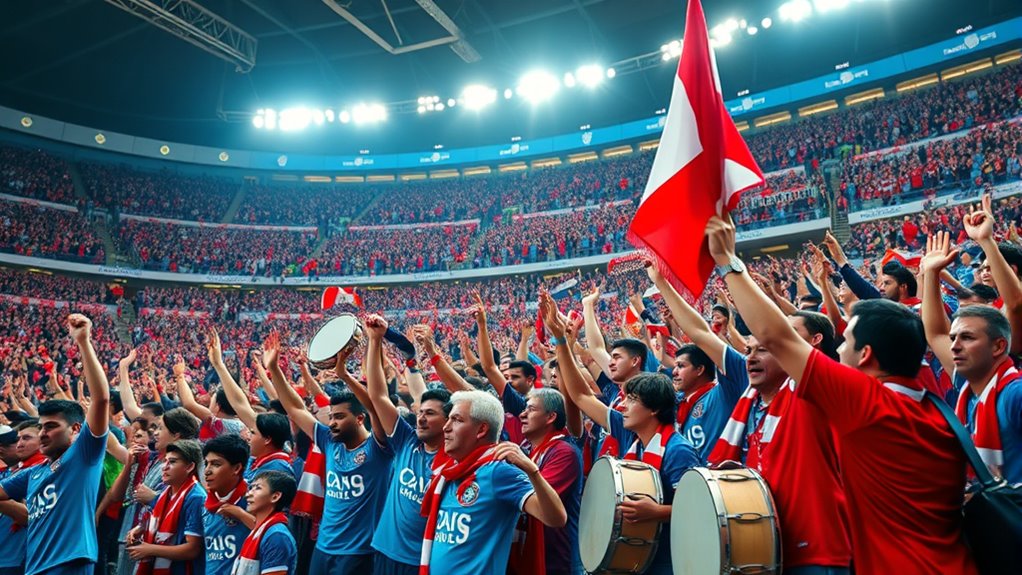
When you join a fandom, you start to see how group identity shapes your connection to others and the team. Your emotional investment grows as you share victories and setbacks, strengthening your bond with fellow fans. These social dynamics create a powerful sense of belonging that keeps you rooted in the community. Additionally, shared rituals and symbols, such as team colors, reinforce these group identity bonds, making the experience more immersive and meaningful.
Group Identity Formation
Social bonding plays a essential role in shaping group identity, especially in fan communities where shared passions foster strong connections. Sports psychology shows that these bonds create a sense of belonging, giving fans a collective identity that extends beyond the game. Recognizing fan demographics helps teams tailor experiences that reinforce group cohesion and loyalty. When you wear your team’s colors, you’re not just supporting a team—you’re signaling your place within a larger community. Group identity forms through rituals, chants, and shared experiences that amplify social bonds. These dynamics make fans feel part of something bigger than themselves, strengthening loyalty and collective pride. Incorporating mindfulness practices into fan activities can further deepen emotional connection and enhance overall well-being. Ultimately, this sense of belonging fuels the passion and commitment that keeps fans connected season after season.
Emotional Investment Dynamics
Your emotional investment in a team deepens through the social bonds formed with fellow fans, creating a powerful sense of shared purpose. When you wear fan merchandise, you’re not just showing support; you’re connecting with others who feel the same passion. Rivalries and drama intensify these bonds, fueling conversations and emotional reactions that strengthen group loyalty. Cheering together during games builds camaraderie, making victories sweeter and losses more painful. Engaging in debates about rival teams or dramatic moments reinforces your sense of belonging. These social dynamics turn individual support into a collective identity, where the group’s emotional investment becomes personal. Additionally, understanding privacy policy practices helps fans recognize how their data might be used during online interactions related to fandom activities. Ultimately, the shared experiences, whether through merchandise or rivalry-driven drama, deepen your attachment and commitment to the team.
Evolutionary Perspectives on Competitive Behavior
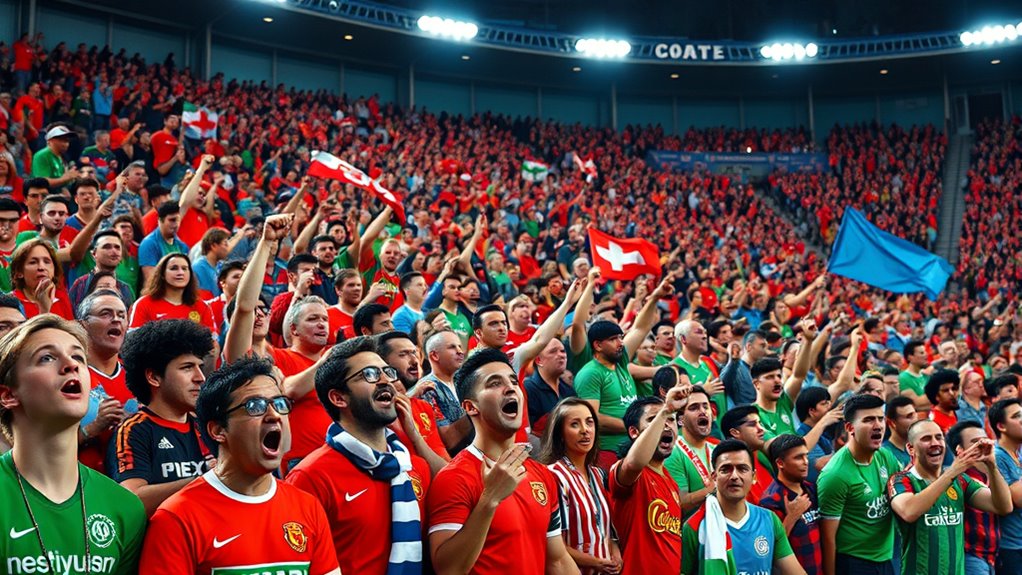
Your loyalty to a team likely has roots in our evolutionary past, where sticking with a group increased chances of survival. Competition among groups helped humans secure resources and defend against threats. Understanding these origins sheds light on why team rivalries feel so instinctively important to you. Additionally, the innate tendency to form and defend group identities is reinforced through social cohesion mechanisms that have been crucial for human survival throughout history.
Group Loyalty Origins
Have humans developed a natural tendency to favor their groups through evolution? Evidence suggests yes. Our ancestors thrived by forming close-knit bonds, which improved survival and cooperation. This instinct now manifests in fandoms, where loyalty to a team reflects deep-rooted social behaviors. Merchandise marketing leverages this loyalty, reinforcing group identity through team colors and memorabilia. Recognizing the fan demographic helps teams target marketing efforts effectively. Below is a table illustrating how group loyalty stems from evolutionary needs:
| Trait | Evolutionary Benefit | Modern Expression |
|---|---|---|
| In-group bias | Increased cooperation | Preference for team merchandise |
| Social bonding | Strengthened alliances | Attending games, fan gatherings |
| Competition | Survival advantage | Rivalries, competitive spirit |
| Identity | Group cohesion | Wearing team colors, fan symbols |
| Loyalty | Long-term cooperation | Dedication to team success |
Additionally, understanding these innate tendencies can help organizations foster group cohesion and improve team dynamics in various settings.
Competition and Survival
Competition has long been a driving force behind human survival, pushing individuals and groups to outperform rivals and secure resources. Today, this drive manifests in activities like fantasy leagues, where strategic thinking and rivalry boost engagement and group cohesion. Your obsession with merchandise isn’t just about supporting your team; it’s a way to demonstrate allegiance and stand out in a competitive social landscape. These behaviors tap into deep evolutionary instincts to prove your worth and secure social status. By competing—whether through fantasy leagues or collecting team gear—you reinforce bonds with fellow fans and demonstrate loyalty. This competitive spirit fuels your emotional investment, making fandom a modern extension of ancient survival strategies that prioritize outperforming rivals and securing social and psychological resources. Engaging in such fandom activities can also enhance social cohesion, strengthening community ties and collective identity.
The Impact of Rituals and Symbols in Fandom Culture
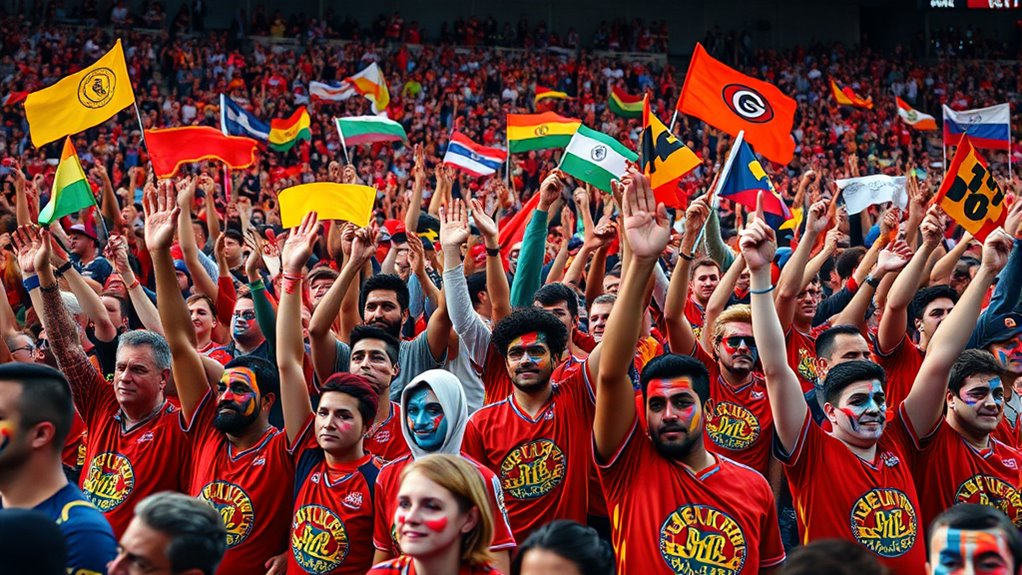
Rituals and symbols play a crucial role in shaping the identity and cohesion of fandom communities. When you participate in ritualistic practices, like chanting cheers or wearing team gear, you reinforce your connection to the group. These rituals create shared experiences that foster a sense of belonging. Symbols also carry deep significance, representing values, history, and pride of your team or community. The symbol significance goes beyond mere visuals; it becomes a rallying point that unites fans emotionally. Engaging with glycolic acid products and their associated rituals can serve as a metaphor for how fans engage with symbols and traditions, emphasizing the importance of shared practices in maintaining group identity. By engaging with these rituals and symbols, you help maintain tradition and strengthen collective identity. This shared language and shared practices make your fandom more meaningful, transforming individual support into a powerful communal bond rooted in tradition and symbolism.
How Fandom Shapes Self-Concept and Personal Identity
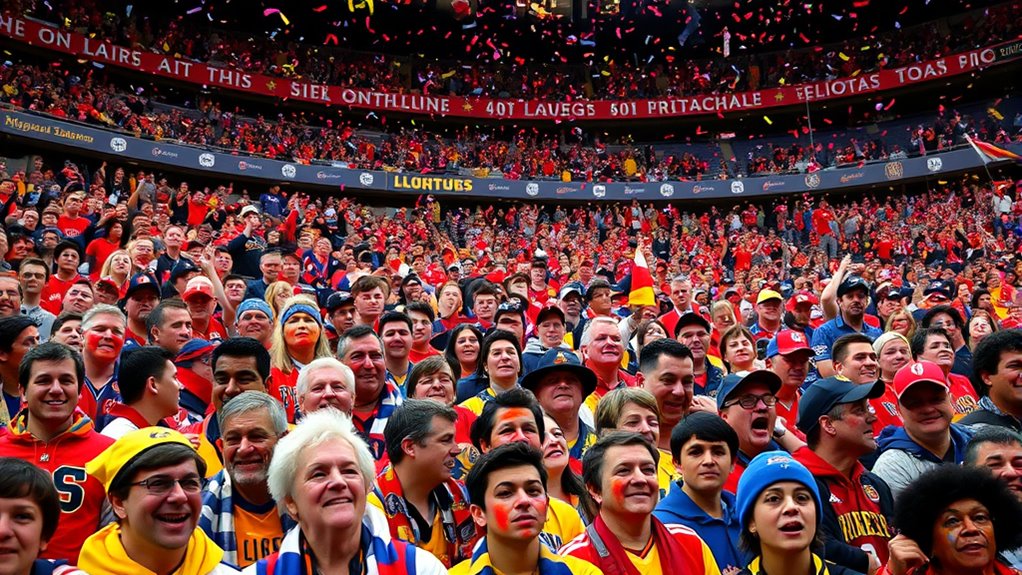
Participating in fandoms and engaging with their symbols and rituals often becomes a defining part of how you see yourself. Your identity intertwines with team colors, logos, and shared chants, shaping your self-concept. This connection influences your choices, from clothing to social circles. Fashion trends driven by fandom communities often reflect your allegiance, making your identity visible. Celebrity endorsements further reinforce your sense of belonging, as public figures endorse teams, amplifying your loyalty.
Consider how fandom impacts your personal narrative:
- It aligns your self-image with collective values and symbols
- It influences your fashion choices to signal your loyalty
- It fosters a sense of pride and community
- It transforms external symbols into internal identity markers
- It integrates fandom into your daily life and personal style
The Psychological Benefits of Supporting a Team
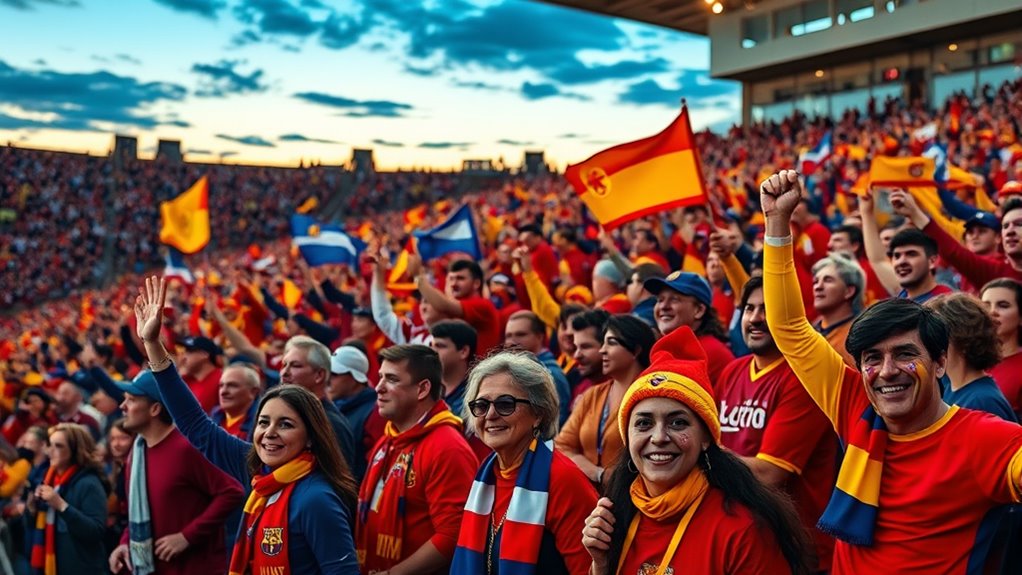
Supporting a team can provide real psychological benefits, offering a sense of stability and purpose. When you engage with your team, you often practice mindfulness, staying present during games and moments of celebration or disappointment. This focus can reduce stress and improve your overall well-being. Additionally, supporting a team encourages cognitive reframing—you learn to see setbacks as temporary and part of a larger journey. This perspective fosters resilience and helps you manage life’s challenges better. Being part of a fandom creates a community where shared experiences strengthen your sense of belonging. These psychological benefits can boost your confidence, promote emotional balance, and give you a consistent source of motivation, making your support for the team more than just entertainment—it’s an essential part of your mental health. Recognizing the importance of vetted products and practices can also enhance your overall experience and safety as a fan.
Emotional Intensity and the Experience of Fandom
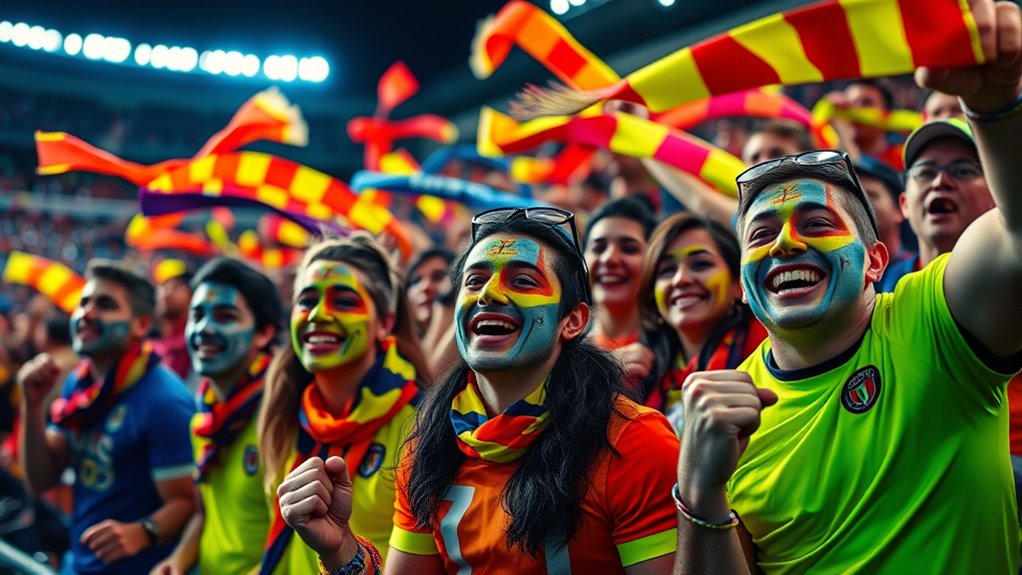
Fandom often amplifies the emotional highs and lows experienced during sports events, making every game more than just a contest. Your passion intensifies as you connect emotionally through sports psychology, heightening feelings of joy, frustration, and pride. This emotional intensity fuels your loyalty and engagement, making victories exhilarating and losses deeply personal. You subconsciously seek out ways to strengthen these bonds through fandom marketing, reinforcing your identity as a dedicated supporter. Celebrity transformations such as changes in appearance or lifestyle can also influence fan perceptions and emotional connections.
- Enhances sense of belonging
- Deepens personal investment
- Triggers physiological responses (adrenaline, endorphins)
- Elevates communal experiences
- Reinforces team identity and loyalty
The Influence of Media and Community on Fandom Loyalty
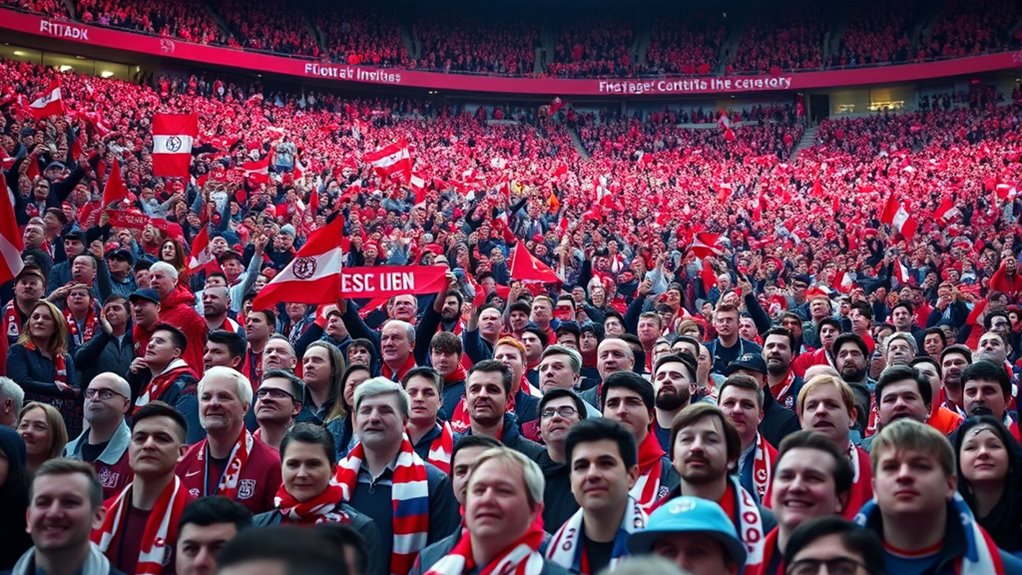
Media and community play essential roles in shaping your loyalty to a team by consistently reinforcing its identity and values. Through media coverage, you’re exposed to team stories, highlights, and fan merchandise that strengthen your connection. Community involvement, like attending games or participating in fan rituals, deepens your sense of belonging. These rituals—chanting, waving flags, or wearing team colors—create shared experiences that boost your allegiance. Social media platforms amplify team narratives, making you feel part of a larger fan base. The constant presence of fan merchandise, from jerseys to scarves, serves as visible symbols of your loyalty. Additionally, tuning modifications for vehicles can serve as a metaphor for personalizing and strengthening your connection to your team or community. Together, media and community interactions solidify your emotional bond, making your team support more than just a hobby—it becomes a core part of your identity.
Frequently Asked Questions
How Do Fandoms Develop Their Unique Traditions Over Time?
Think of fandoms as gardens growing over time, where each new tradition is a seed planted through shared experiences. As fans gather, cheer, and celebrate, these rituals evolve, blending old customs with new ones. Over generations, this ritual evolution preserves core traditions while embracing change, creating a unique identity. You become part of this living history, shaping and passing down your team’s spirit through every chant, banner, and memory you cherish.
Can Fandom Loyalty Influence Real-World Decision-Making or Behavior?
Your fandom loyalty can definitely influence your real-world decisions and behaviors. Peer pressure often plays a role, encouraging you to support your team even if it means making choices that align with group norms. It also shapes your consumer behavior, prompting you to buy team merchandise or attend games to show your allegiance. This collective identity boosts your sense of belonging, making your loyalty a powerful force in your daily life.
What Neurological Processes Are Involved in Emotional Responses to Team Wins or Losses?
Think of your brain as a symphony, where neural pathways fire with excitement or despair. When your team wins or loses, your amygdala sparks intense emotions, while the prefrontal cortex manages emotional regulation. These processes create powerful responses—joy, frustration, or disappointment—that deepen your connection to the game. Your brain’s emotional circuitry turns sporting events into emotionally charged experiences, making fandom feel like a rollercoaster ride.
How Do Fandoms Adapt to Changes in Team Performance or Management?
You adapt to changes in team performance or management by leaning on your fandom identity and engaging with fan community dynamics. When your team shifts, you might deepen your connection or seek new ways to support, keeping your passion alive. These adjustments help you maintain emotional investment, foster camaraderie, and redefine your sense of belonging, even amidst uncertain or evolving team circumstances. Your loyalty fuels your resilience and ongoing engagement.
Are There Differences in Fandom Attachment Across Different Cultures or Age Groups?
You’ll notice that fandom attachment varies across cultures and age groups. Cultural identity heavily influences how deeply you connect to your team, shaping your loyalty and passion. Younger fans might display age-related loyalty, showing intense enthusiasm but shifting allegiances more easily. Older fans often have a stronger, more enduring attachment. These differences stem from cultural values and personal experiences, making each fan’s connection uniquely shaped by their background and age.
Conclusion
Your passion for your team runs deeper than just winning or losing. It’s rooted in psychological and social factors, shaping your identity and bonding you with others. Some theories suggest fandom may even tap into evolutionary drives for group cohesion and competition. So, the next time you wear your colors with pride, remember—you’re part of a complex, instinctual tradition that connects you to a larger human story of belonging and rivalry.
